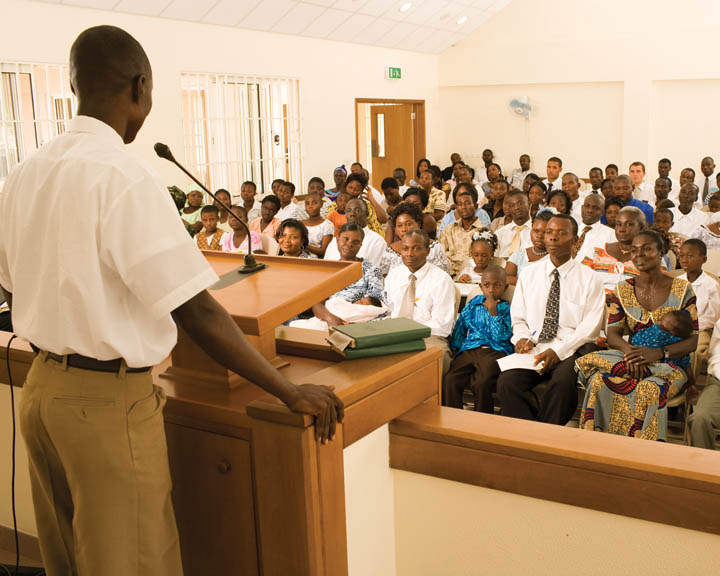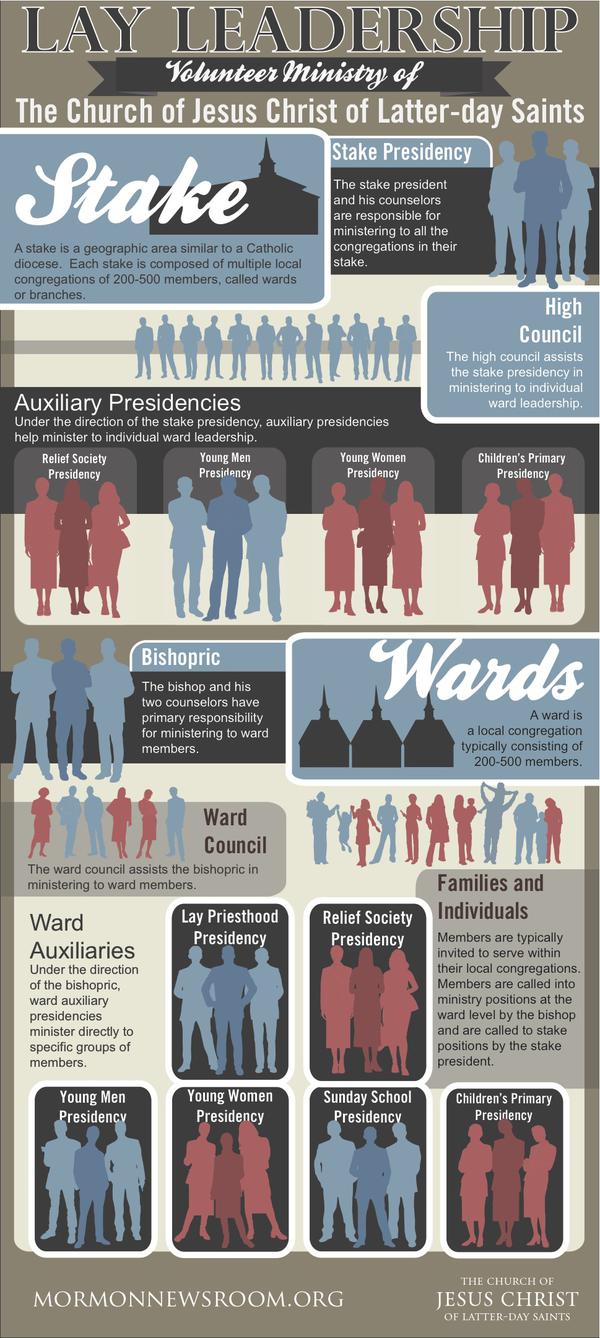Difference between revisions of "Ward"
(→Ward Conference) |
(→Special Needs wards) |
||
| (8 intermediate revisions by 2 users not shown) | |||
| Line 3: | Line 3: | ||
===Origin of the term ''Ward''=== | ===Origin of the term ''Ward''=== | ||
| − | [[image:Mormon Church Meeting.jpg|350px|right|alt=Mormon Ward Church Meeting|Mormon Ward Church Meeting]]After | + | [[image:Mormon Church Meeting.jpg|350px|right|alt=Mormon Ward Church Meeting|Mormon Ward Church Meeting]]After [http://Mormon.org The Church of Jesus Christ of Latter-day Saints] was organized, there was no real formal name for units of the Church, as the Church was quite small at the time. It was only during the period when the Church was headquartered in Nauvoo, Illinois, that the term ''ward'' became associated with a local unit of the Church. |
| − | At the time, | + | At the time, ''ward'' was the title for a local political district. Illinois, from the early days of the state, used the term to describe such political subdivisions of a city, and still uses it today to describe these subdivisions. So naturally, the Church took the name, and it has remained in use to this day. |
===Makeup of a ward=== | ===Makeup of a ward=== | ||
| Line 15: | Line 15: | ||
===Leadership and organization in wards=== | ===Leadership and organization in wards=== | ||
| − | A ward is presided over by a [[bishop]], who has two counselors. Each ward typically has at least one [[elder]]'s quorum | + | A ward is presided over by a [[bishop]], who has two counselors. Each ward typically has at least one [[elder]]'s quorum and a [[Relief Society]]. There are also the [[Primary]] organization for children, [[Young Women]], and [[Young Men]] organizations in each ward. Young men belong to the quorums of the [[Aaronic Priesthood]] set up in each ward. |
===Dividing wards=== | ===Dividing wards=== | ||
| − | When a ward gets too large, the stake president seeks approval to divide the ward into two distinct wards, or even more wards if the growth in the ward necessitates it. A meeting is held with the ward to announce the new ward boundaries and announce the new bishop of the new ward and sometimes the old ward that the new ward is taken from. | + | When a ward gets too large, the stake president seeks approval to divide the ward into two distinct wards, or even more wards if the growth in the ward necessitates it. Sometimes a few ward boundaries are realigned when creating a new ward. A meeting is held with the ward to announce the new ward boundaries and announce the new bishop of the new ward and sometimes the old ward that the new ward is taken from. |
===Special Needs wards=== | ===Special Needs wards=== | ||
| − | In order to provide for specific needs of Church members, there are wards created to meet those needs. The best known are | + | In order to provide for specific needs of Church members, there are wards created to meet those needs. The best known are young single adult wards (YSA) where young adults ages 18 to 30 can attend together. In areas with large ethnic concentrations there are often wards where everyone speaks the minority language. Spanish-language units in the United States are the most common of these. Wards for those with certain disabilities such as deafness, are also formed in some areas. |
| − | If there are enough college-age students in an area, local leaders may request a ward be formed for the students in that area, and the ward meets as near the college or university as is practical. | + | If there are enough college-age students in an area, local leaders may request a ward be formed for the students in that area, and the ward meets as near the college or university as is practical. [[Brigham Young University]] is the most well-known of these, with over 225 wards at last count. In fact, most classroom buildings at BYU are used for Church services on Sunday and each building may have a number of wards meeting at various times. In 2011, the Church built a 4-stake, 48-ward meetinghouse in Provo, Utah, a few blocks south of BYU, where leadership and clerk offices and interview rooms for those stakes and wards are housed. The building can host stake conferences of around 2,000 participants. |
===Meetinghouses=== | ===Meetinghouses=== | ||
| − | Wards meet in | + | Wards meet in [[Meetinghouse|meetinghouses]], commonly referred to as ''[[Chapel|chapels]]'' by many, although in the Church the chapel is the main room in the building where Sacrament meeting is held. In less populated areas, a meetinghouse may hold only one ward, but in most cities a meetinghouse will house from two to four wards, each ward starting its schedule a couple of hours after the ward before it. In rare instances due to fast growth, more than four wards will meet in a meetinghouse. |
| − | Due to expense and other considerations, larger meetinghouses with two or even occasionally more chapels are being built now | + | Due to expense and other considerations, larger meetinghouses with two or even occasionally more chapels are being built now; these will accommodate from six to 12 wards on any Sunday. |
| − | A Stake | + | A Stake comprises from five to fifteen wards, although some student or YSA wards may be in stakes of up to 20 units, since their membership population may be less, and one meetinghouse within the stake is referred to as the [[Stake Center]]. This is where members and leaders go to meet with the stake officers, and where [[Stake Conference|stake conference]] is held. |
===Ward Conference=== | ===Ward Conference=== | ||
| − | Like a 'stake conference', wards have a 'ward conference' each year. The stake presidency comes and speaks to the ward, and holds other meetings with ward members and leaders. Generally the ward conference is held | + | Like a ''stake conference'', wards have a ''ward conference'' each year. The stake presidency comes and speaks to the ward, and holds other meetings with ward members and leaders. Generally the ward conference is held during the first few months of the year, but in some areas that can vary. |
[[Image:LDS_Lay_Ministry_Info-Graphic.jpg|200px|thumb|alt=LDS Lay Clergy Info-graphic|center|Click on this graphic to enlarge, then click zoom to read.]] | [[Image:LDS_Lay_Ministry_Info-Graphic.jpg|200px|thumb|alt=LDS Lay Clergy Info-graphic|center|Click on this graphic to enlarge, then click zoom to read.]] | ||
| + | |||
| + | *[http://www.mormonnewsroom.org/article/mormon-lay-ministry A thorough explanation of the lay ministry of the LDS Church] | ||
[[Category: Church Organization]] | [[Category: Church Organization]] | ||
Revision as of 14:52, 15 June 2018
A local congregation of about three hundred to eight hundred members. Ward boundaries are determined geographically. Typically, several wards compose a Stake.
Contents
Origin of the term Ward
After The Church of Jesus Christ of Latter-day Saints was organized, there was no real formal name for units of the Church, as the Church was quite small at the time. It was only during the period when the Church was headquartered in Nauvoo, Illinois, that the term ward became associated with a local unit of the Church.At the time, ward was the title for a local political district. Illinois, from the early days of the state, used the term to describe such political subdivisions of a city, and still uses it today to describe these subdivisions. So naturally, the Church took the name, and it has remained in use to this day.
Makeup of a ward
Wards can be very large or cover only a few blocks, depending on how many members of the Church reside within the geographical boundaries of the ward. Utah wards may cover the area of only six blocks in places, while some wards may stretch for miles.
Usually about 250 members live within a ward's geographical boundaries, but in Utah it can be between 300 and 450. Large wards are uncommon, but can be the result of explosive growth in a given area, such as new suburbs of a fast-growing city.
Leadership and organization in wards
A ward is presided over by a bishop, who has two counselors. Each ward typically has at least one elder's quorum and a Relief Society. There are also the Primary organization for children, Young Women, and Young Men organizations in each ward. Young men belong to the quorums of the Aaronic Priesthood set up in each ward.
Dividing wards
When a ward gets too large, the stake president seeks approval to divide the ward into two distinct wards, or even more wards if the growth in the ward necessitates it. Sometimes a few ward boundaries are realigned when creating a new ward. A meeting is held with the ward to announce the new ward boundaries and announce the new bishop of the new ward and sometimes the old ward that the new ward is taken from.
Special Needs wards
In order to provide for specific needs of Church members, there are wards created to meet those needs. The best known are young single adult wards (YSA) where young adults ages 18 to 30 can attend together. In areas with large ethnic concentrations there are often wards where everyone speaks the minority language. Spanish-language units in the United States are the most common of these. Wards for those with certain disabilities such as deafness, are also formed in some areas.
If there are enough college-age students in an area, local leaders may request a ward be formed for the students in that area, and the ward meets as near the college or university as is practical. Brigham Young University is the most well-known of these, with over 225 wards at last count. In fact, most classroom buildings at BYU are used for Church services on Sunday and each building may have a number of wards meeting at various times. In 2011, the Church built a 4-stake, 48-ward meetinghouse in Provo, Utah, a few blocks south of BYU, where leadership and clerk offices and interview rooms for those stakes and wards are housed. The building can host stake conferences of around 2,000 participants.
Meetinghouses
Wards meet in meetinghouses, commonly referred to as chapels by many, although in the Church the chapel is the main room in the building where Sacrament meeting is held. In less populated areas, a meetinghouse may hold only one ward, but in most cities a meetinghouse will house from two to four wards, each ward starting its schedule a couple of hours after the ward before it. In rare instances due to fast growth, more than four wards will meet in a meetinghouse.
Due to expense and other considerations, larger meetinghouses with two or even occasionally more chapels are being built now; these will accommodate from six to 12 wards on any Sunday.
A Stake comprises from five to fifteen wards, although some student or YSA wards may be in stakes of up to 20 units, since their membership population may be less, and one meetinghouse within the stake is referred to as the Stake Center. This is where members and leaders go to meet with the stake officers, and where stake conference is held.
Ward Conference
Like a stake conference, wards have a ward conference each year. The stake presidency comes and speaks to the ward, and holds other meetings with ward members and leaders. Generally the ward conference is held during the first few months of the year, but in some areas that can vary.

